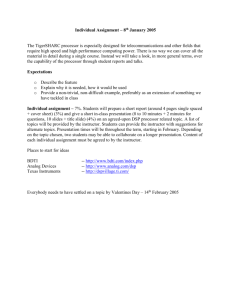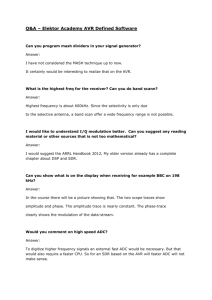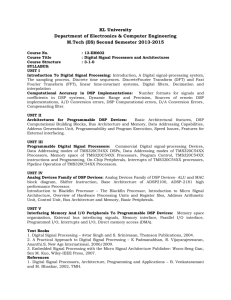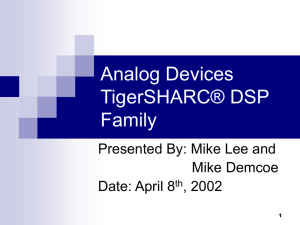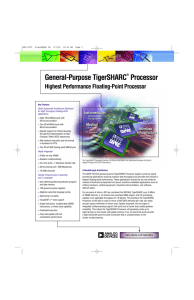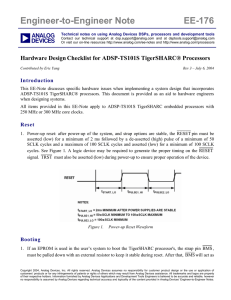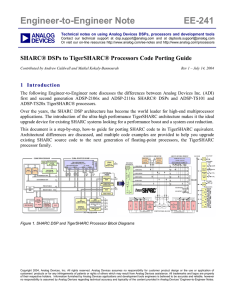2002 Rethinking Base Station, Baseband Processing for Wireless
advertisement
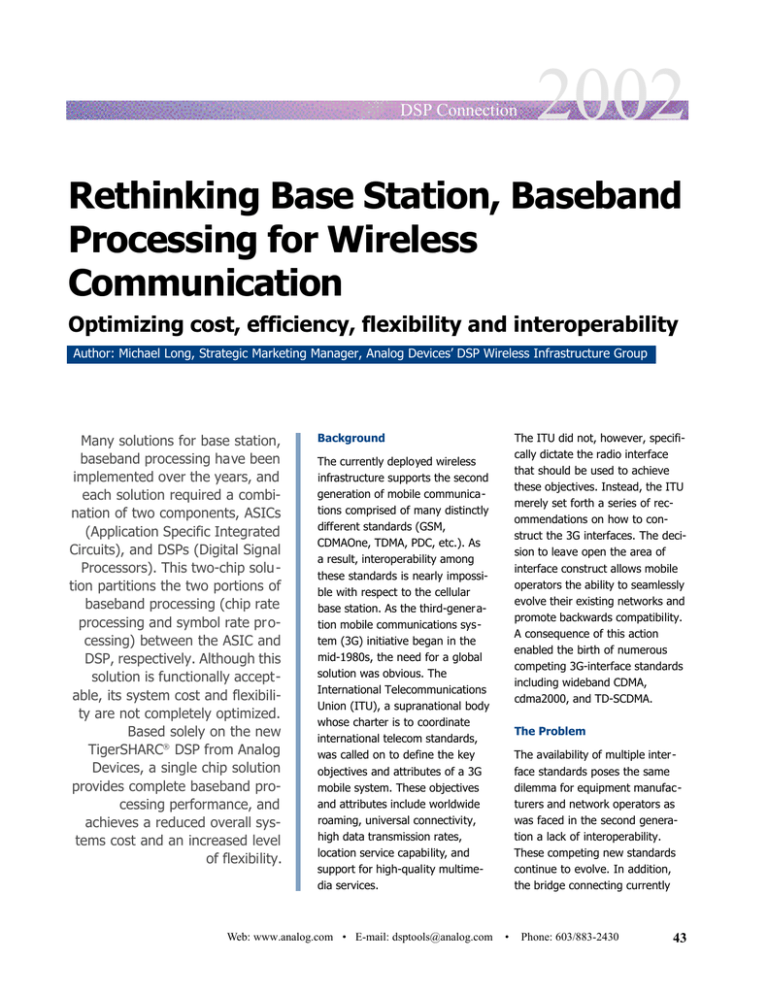
DSP Connection 2002 Rethinking Base Station, Baseband Processing for Wireless Communication Optimizing cost, efficiency, flexibility and interoperability Author: Michael Long, Strategic Marketing Manager, Analog Devices’ DSP Wireless Infrastructure Group Many solutions for base station, baseband processing have been implemented over the years, and each solution required a combination of two components, ASICs (Application Specific Integrated Circuits), and DSPs (Digital Signal Processors). This two-chip solution partitions the two portions of baseband processing (chip rate processing and symbol rate processing) between the ASIC and DSP, respectively. Although this solution is functionally acceptable, its system cost and flexibility are not completely optimized. Based solely on the new TigerSHARC® DSP from Analog Devices, a single chip solution provides complete baseband processing performance, and achieves a reduced overall systems cost and an increased level of flexibility. Background The ITU did not, however, specifically dictate the radio interface that should be used to achieve these objectives. Instead, the ITU merely set forth a series of recommendations on how to construct the 3G interfaces. The decision to leave open the area of interface construct allows mobile operators the ability to seamlessly evolve their existing networks and promote backwards compatibility. A consequence of this action enabled the birth of numerous competing 3G-interface standards including wideband CDMA, cdma2000, and TD-SCDMA. The currently deployed wireless infrastructure supports the second generation of mobile communications comprised of many distinctly different standards (GSM, CDMAOne, TDMA, PDC, etc.). As a result, interoperability among these standards is nearly impossible with respect to the cellular base station. As the third-gener ation mobile communications system (3G) initiative began in the mid-1980s, the need for a global solution was obvious. The International Telecommunications Union (ITU), a supranational body whose charter is to coordinate international telecom standards, was called on to define the key objectives and attributes of a 3G mobile system. These objectives and attributes include worldwide roaming, universal connectivity, high data transmission rates, location service capability, and support for high-quality multimedia services. Web: www.analog.com • E-mail: dsptools@analog.com The Problem The availability of multiple interface standards poses the same dilemma for equipment manufacturers and network operators as was faced in the second generation a lack of interoperability. These competing new standards continue to evolve. In addition, the bridge connecting currently • Phone: 603/883-2430 43 2002 DSP Connection deployed second-generation systems to 3G systems is continually cluttered by legal, political, economic, and cultural challenges. As a result, the flexibility of baseband processing solutions is becoming a paramount issue among infrastructure equipment manufacturers. Clearly, the need for a single, highly flexible baseband processing solution is greater than ever. Without a single solution, wireless equipment manufacturers would need to ha ve solutions for many, if not all of the major third-generation standards in order to compete on a global level. Without the implementation of a single, flexible, and scalable baseband-processing platform that can be utilized for all of the competing 3G modes, OEMs are faced with escalating engineering costs and significant time-to-market delays. The other issue of great concern among equipment manufacturers and network operators alike is inf rastructure cost. Considering the extremly high prices being paid for a 3G spectrum around the world and the accelerated requirement to deploy profitable 3G networks, equipment manufacturers and network operators are focused on inf rastructure cost reduction. addition, operators must protect the investment over the long run by maximizing the capability of their current technology as it evolves or as additional technologies are adopted and integrated into operations. The equipment manufacturer needs to move designs to platforms that recovery their initial investment in order to have a base-station solution in place for the rollout of 3G networks. Equipment manufacturers must accomplish this while maintaining a practical solution that offers the best possible performance and flexi bility, so their revenue and profit streams continue to flow. Maintaining this cash flow will enable new investment in new 3G applications and technologies to further advance and shape the telecom market. The Solution The widely accepted solution in the market today involves the use of an ASIC and a DSP. ASICs, custom devices designed to execute a specific set of tasks within the baseband Network operators need a cost-effective base-station system that can be tailored to meet the requirements of individual regions or nations. In 44 Phone: 603/883-2430 • E-mail: dsptools@analog.com • processing, typically handle chip rate processing functions. DSPs handle the more complex functionality of the symbol rate processing. The distinct difference between these two types of components is the level of programmability or flexibility they offer the system designer. Once released to production, ASIC functionality cannot be enhanced, increased, or changed without entailing a severe and costly re-design. ASIC re-design can cost an equipment manufacturer dearly on two fronts: cost – engineering expenses invariably run on the order of multiple millions of dollars, and time-to-market, which can take the better part of a year, causing a potential market opportunity to be missed. The DSP, however, is a completely programmable device lending itself quite nicely to a global market of evolving and competing communications standards. In order to integrate the chip-rate and the symbol-rate processing capabilities onto a signal piece of silicon, the device architecture must perform the high-value, complex functions associated with symbol-rate processing and the cumbersome, low-value, highspeed operations found within the chip rate processing. These are key strengths of the new ADSP-TS101S fully programmable TigerSHARC DSP from Analog Devices. The TigerSHARC, through its proprietary architecture and enhanced instruction set, provides complete baseband pro- Web: www.analog.com DSP Connection cessing capabilities and provide unmatched flexibility and interoperability. The TigerSHARC DSP is a VLIW (very long instruction word) device that permits multiple instructions per line, and therefore reduces the overall cycle count required to perform 3Grelated functions such as channel decoding, despreading, and path searches. Since the acceleration capabilities reside in software rather than in static hardware blocks or coprocessors, TigerSHARC DSPs provide the flexibility, scalability, and interoperability needed in today’s highly competitive market. These characteristics and the directly associated benefits elevate the TigerSHARC and this “Software Radio” approach as the optimal baseband processing solution available today. Benefits of a Software-Based Solution When equipment manufacturers design a software-based solution, it enables the adoption of a single, highly flexible platform, providing the ability to adapt to any of the existing second-generation or the five com peting 3G standards, thus dramatically reducing time to market. This increased flexibility is not lost on the network operators either. The deployment of a completely scalable base station platform not only equates to easier potential updates in the future, but also allows for the immediate interoperability of two or more competing standards, providing greater support for roaming terminals from foreign networks. As a result, by deploying a software-based solution to baseband-signal processing, network operators can accomplish the closest thing to the concept of global roaming, which was clearly one of the original expectations of the 3G wireless development. Reduced system cost is also addressed by the Software Radio approach. If the complete basebandprocessing functionality is contained in one device, reduced system cost follows. The ADSP-TS101S TigerSHARC DSP, through a technique called “load balancing,” dynamically shifts its processing power between chip-rate and symbol-rate requirements, according to the channel profile at any given time. “Load balancing” eliminates the costly underutilized processing bandwidth found in currently deployed two-chip baseband processing solutions. Additionally, the existence of an optimized instruction set for wireless communications, used by the TigerSHARC DSP, accomplishes the required tasks found in baseband processing with a higher degree of efficiency, enabling remaining processor instruction bandwidth to handle added functionality in the future. Increased on-chip memory and an advanced bandwidth structure are also available on this new breed of programmable DSP, further reducing component count and overall system cost. Designing base station, baseband-processing solutions using the Software Radio approach can resul t in up to a 50% reduction in cost per Web: www.analog.com • E-mail: dsptools@analog.com 2002 channel versus the widely uti lized two-chip approach. Other cost advantages found on the TigerSHARC DSP include high internal-bus bandwidth and external state-of-the-art multiprocessing hooks that allow best-in-class processor throughput and low cost, efficient inter-processor communications, and the elimination of additional glue logic. The TigerSHARC DSPs’ low power consumption (< 1 W) and industry-standard, plastic, ball-gridarray packaging further reduce sys tem cost by removing the need for ceramic packaging and power dissipation techniques such as heat sinks and forced-air cooling, commonly found in many competing solutions. Summary With the deployment of a 3G-wireless infrastructure on the horizon, equipment manufacturers and network operators are searching for a completely optimized baseband solution that allows the greatest degrees of freedom in the areas of cost, efficiency, flexibility, and interoperability. Keeping in mind the dilemmas of the past, the needs of the present, and the challenges of future, basebandprocessing component selection has been made easy by the introduction of the new TigerSHARC DSP from Analog Devices and the softwarebased solutions that harness its unique performance and cost-reduction attributes. For more information, visit www.analog.com/TigerSHARC • Phone: 603/883-2430 45
